What Picture Books Add to a Middle School Class
Click on covers to learn more about the featured books!
By Katie Durkin

In this class, we participated in book clubs, read multiple whole-class novels, and discussed modern trends in middle grade and young adult texts, all with the purpose of taking these strategies into the classroom.
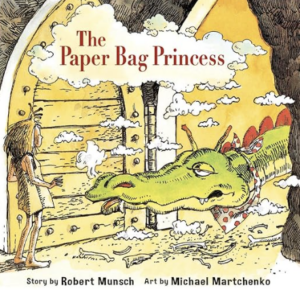
Our first read-aloud was The Paper Bag Princess by Robert Munsch. We discussed how this particular picture book could be used as a model for teaching theme. I remember thinking how brilliant this idea was at the time, even going as far as to purchase a copy of the picture book with what little money I had as an undergrad.
But it wasn’t until the past two school years that I really started embracing reading picture books – for three reasons. I believe that including picture books in my curricula in middle school invokes a sense of nostalgia for the students, helps them to grasp difficult abstract concepts, and creates a shared experience I can leverage in the future.
Nostalgia is a powerful influencer for many people, but I would argue it’s especially so for middle schoolers. At first I was nervous about bringing back a story time element in my classroom. Knowing middle schoolers’ personalities, I expected there to be a bit of pushback, and the first time I tried it, some of them did grumble and grip.
But now that I have used picture books with two different cohorts of students, I have seen how much they love story time and miss it from their elementary days. I actually create a space in my classroom where students can comfortably sit on the floor and be able to see the pictures in the story.
I approach these read alouds in a number of different ways, depending on the focus for the day’s lesson. Sometimes I will structure it like a traditional read aloud, where I will demonstrate my own thinking, purposely stopping at different points in the story.
Other times I ask students to make sure they have someone to talk to as I’ve strategically found places in the picture book for discussion.
Sometimes I will read a whole picture book in one sitting. Other times I will stop at particular places to leave the students hanging because the pages of the day directly relate to our lesson.
Many of my students love story time so much they actually request it if we haven’t done it for a while. Being read to is a powerful practice: it allows students to focus more on the story through the images (enjoyment) and also grasp more difficult concepts they can apply to their own reading (growth).
Encouraging abstract thinking
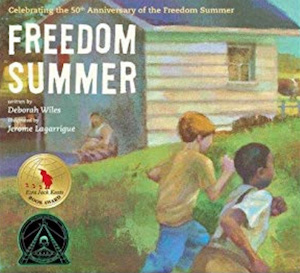
Two of our biggest units of the year are historical fiction and social justice. Here students are asked to think about really difficult concepts. In historical fiction, students are asked to consider how authors use history to tell fictional stories. In our social justice unit, they explore the topics of power, privilege, change agentry, empathy, and activism.
Each of these units requires students to use both fiction and nonfiction to synthesize their thinking about key concepts, which is not an easy task. In the historical fiction unit we read one picture book alongside Newsela articles to figure out how the author used history in the fictional story.
In our social justice unit we read various picture books about many different topics and use the characters’ stories to think about the roles that power, privilege, empathy and activism play in a particular book.
Students also look for change agents and begin to develop theories about traits change agents possess that help them bring about positive, or in some cases, negative change. I have noticed they are better able to grasp these concepts using the picture books as an anchor before applying strategic thinking to their own more text-driven books.
Creating shared experiences
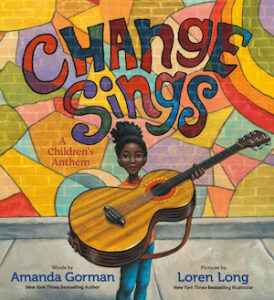
When I pull students to review these concepts, I have been able to fall back on using the picture books as examples to spark conversations that prime their thinking.
I have directly seen the impact this has on students, They are able to see how they can apply a difficult concept – for example power or privilege – to a picture book and then work to transfer it to their own story or a chapter book they are reading.
The picture books I have read to the class have been integral in providing these shared experiences. I have even been able to refer back to many different titles we read earlier in the year when conferring with students. Arguably, this has been the most important part of integrating picture books in my classroom.
In summary, I find that reading these books to the whole class has provided me with an arsenal of diverse tools that help me meet the students where they are.
Finding the picture books
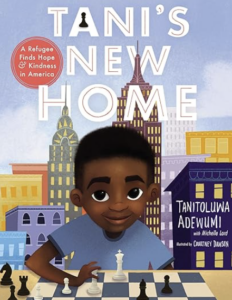
I’ve turned to two places. First, I worked with my library media specialist who has a wealth of knowledge. I went in with the specific purpose of finding books to relate to our historical fiction and social justice units, and she was able to provide me a myriad list of options that I then perused to choose books that would best fit the units.
I’ve also used the internet, reading blogs and reviews on various websites to choose books that were recent and relevant. There are so many resources available to teachers now to find picture books that will fit any need – from the School Library Journal to GoodReads.
I’m now fortunate that I have a stockpile of books to choose from in the future. I also plan to grow my collection as new titles are released and reviewed.
I’ve moved from skeptic to advocate
I know reading picture books in the English Language Arts classroom is not a novel idea. But as a past skeptic of using this strategy with middle schoolers, I can say that this is a practice I plan to use consistently in years to come.

I will end with a call of action. Think about places in your own curriculum where you can infuse picture books. This practice doesn’t need limited to be limited the English Language Arts classroom. Picture books can be used in myriad ways across disciplines and could be a great addition to your classroom routines.
Dr. Katie Durkin (@kmerz610) has been teaching middle school students for over a decade, and currently teaches English Language Arts at public Middlebrook School in Wilton, Connecticut, where she is the 7th Grade Team Leader.
Katie is a zealous reader of middle grade and young adult books and enjoys sharing her love and passion for reading with her students. In 2022 she earned her doctorate from Northeastern University, where her dissertation research examined the impact of classroom libraries on middle school students’ reading engagement.
Katie was the 2020 recipient of the Edwyna Wheadon Postgraduate Training Scholarship from the NCTE. She writes regularly for MiddleWeb and in early 2023 launched a podcast, That’s Novel Reading.

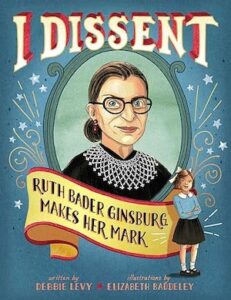
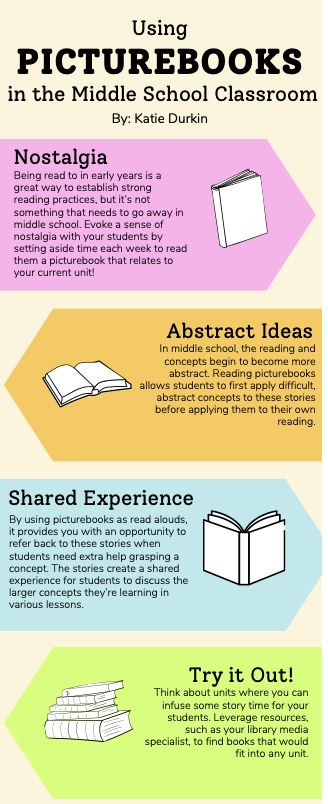




























This is so inspiring! Thank you!
This approach provides a needed balance between decoding words to get the gist of a text and digging deeper into the meaning and themes of texts that all students can be successful with. A great way to support the love of reading and to introduce strategies for text analysis that can be used with more complex texts.
This approach provides a needed balance between decoding words to get the gist of a text and digging deeper into the meaning and themes of texts that all students can be successful with. A great way to support the love of reading and to introduce strategies for text analysis.